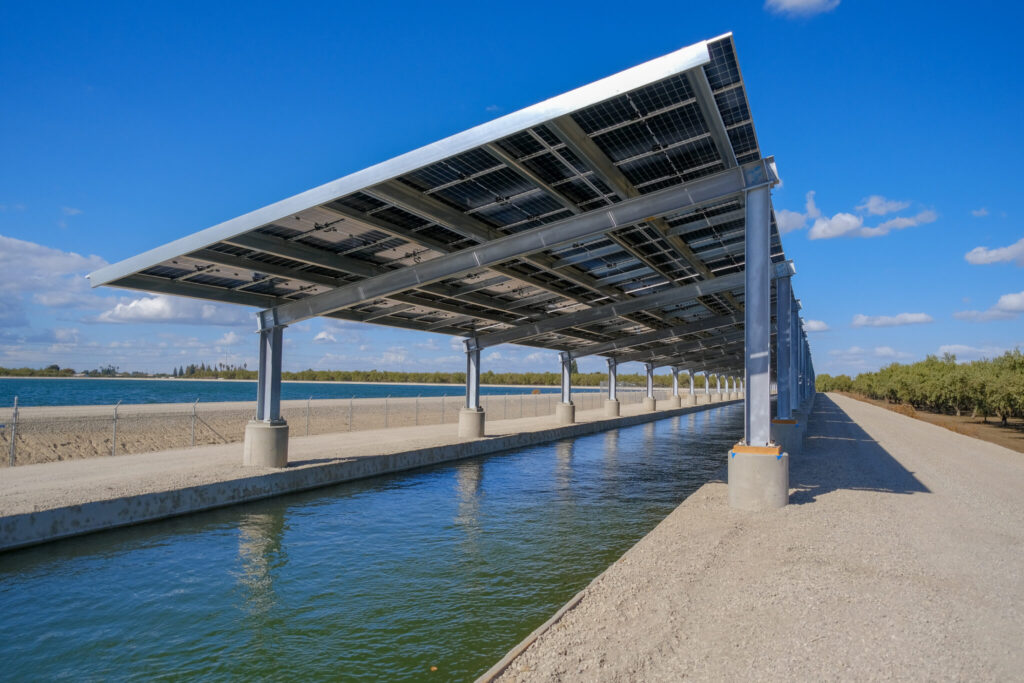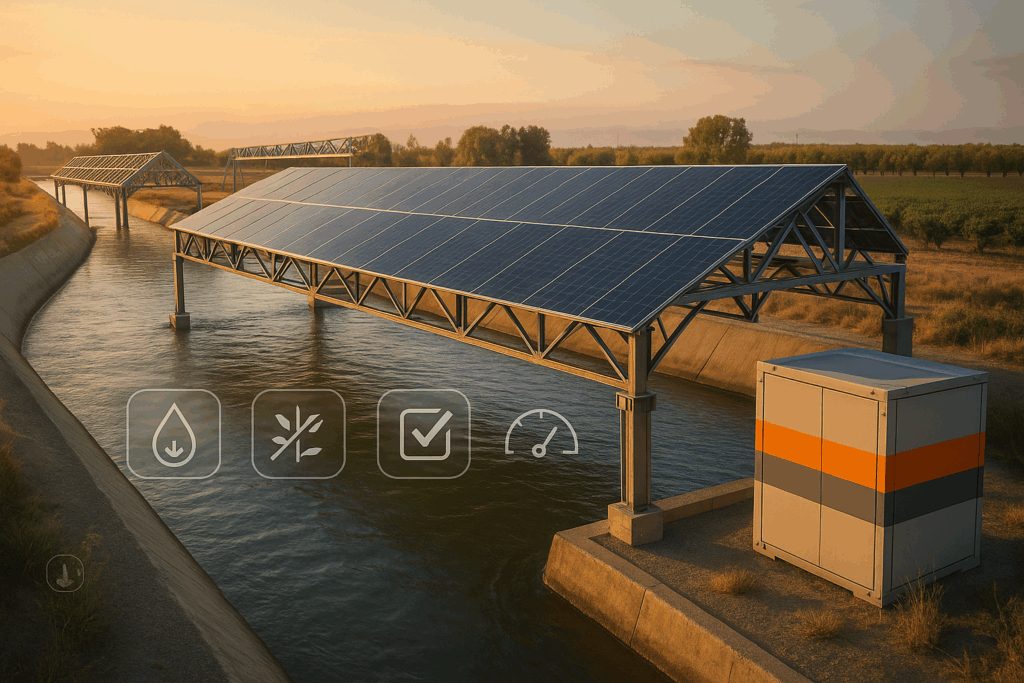Project Nexus has switched on in California’s Central Valley, spanning irrigation canals with 1.6 MW of solar. The real question now: can utilities prove — and monetize — the water they save?
Near Hickman, outside Modesto, a steel lattice now vaults a 110-foot-wide irrigation canal. Photovoltaic panels throw a hard shadow across the water; below, pumps and gates thrum on the Turlock Irrigation District’s (TID) network. Project Nexus — a $20 million state-funded pilot — finished its wide-span installation at the end of August after energising a narrower, 20-foot-wide section in March. Together they deliver a modest 1.6 MW to TID’s grid, with researchers poised to study what matters most for agriculture: water.
Table of Contents
ToggleWhy this matters now
California’s canals are both lifeline and liability in a hotter, drier climate. Covering them with solar has long promised a double dividend: land-saving power and water conserved from evaporation and weed growth. The concept moved from modelling to metal only this year in the state, with TID’s two spans fully commissioned in August. The district is frank that quantifying water benefits will require a full irrigation season of data — but that is precisely the point of the pilot.
The experiment also includes storage. At the narrow-span site TID has paired the array with 75 kW of iron-flow batteries, a chemistry designed for long service and non-toxic siting near waterways. ESS, a US manufacturer, supplied the containers. Storage lets TID shape output for local loads and stress-test operations once the sun moves off the canal.
The measurable promise — and the premium
It is easy to cheer a ribbon-cutting; harder to pay for the steel. Spanning water is dear. Elevated structures, corrosion-resistant hardware and constrained access all mean canal-top arrays cost far more than ground-mount solar. Reporting from the commissioning makes the trade-off plain: Project Nexus cost roughly $20 million for 1.6 MW — a headline number that invites scepticism unless the “co-benefits” show up in the ledger.
Those co-benefits are not invented in a press release. A 2021 study led by University of California researchers estimated that shading California’s ~6,350 km of canals could reduce annual evaporation by 39,000 ± 12,000 m³ per kilometre — about 31.6 ± 9.7 acre-feet per kilometre per year — and, at statewide scale, save ~63 billion gallons of water while enabling ~13 GW of solar capacity. The modelling also suggested that certain cable-supported designs could deliver 20–50% higher net present value than comparable ground-mounts once water and vegetation-management savings are counted. That is the thesis now being tested by TID on real steel and real water.
Early on-site signals are encouraging. TID says aquatic growth suppression — a major maintenance line item — could be a “huge time and cost” saving if borne out over a year of operations. The district will also examine any cooling-related lift in PV performance from the water below the spans. But officials are careful: until a full season is logged, the scale of water and O&M benefits remains to be proven.

Counting the gallons: MRV or it didn’t happen
If solar-over-canal projects are to scale beyond showcase megawatts, they need rigorous measurement, reporting and verification (MRV) for water outcomes — not just energy.
A credible MRV stack for TID and other districts should include:
- Paired baselines and controls. Instrument shaded and unshaded reaches with identical flow, weather and water-quality sensors; treat seepage and downstream return flows explicitly. Eddy-covariance or large-aperture scintillometry can directly quantify heat fluxes to validate evaporation estimates derived from energy-balance models.
- Vegetation and water-quality monitoring. Use repeat photogrammetry and chlorophyll-a proxies to quantify reductions in aquatic weeds and algal blooms, translating labour and herbicide savings into dollars. TID’s formal goals include these metrics.
- Independent protocols. Map results to the Volumetric Water Benefit Accounting (VWBA) framework used by corporate buyers and disclosure initiatives, so “gallons saved” in the San Joaquin basin can be recognised (and transacted) without double-counting.
Without such discipline, canal-top solar struggles to move from nice to bankable. The US Bureau of Reclamation’s past engineering notes on canal spanning — written for Arizona’s CAP — underline the practical risks: wider waterways mean heavier structures, possible interference with hydraulic operations, and access complications for dredging and inspections. Good MRV won’t make steel cheaper, but it can show where the steel is worth it.
The monetisation pathway most outlets missed
Most coverage casts solar-over-canals as land-saving power plants with side benefits. The overlooked angle is who pays for the water.
Corporate “water replenishment” targets are surging. Frameworks popularised by the CEO Water Mandate and WRI’s VWBA method have created a market where companies buy verified, local water benefits to offset operational footprints. Google, for example, reported 4.5 billion gallons replenished in 2024 across watersheds, often by funding on-farm efficiency. Start-up N-Drip explicitly sells agriculture-based replenishment programmes to corporates, using micro-irrigation retrofits to generate volumetric “gallons saved” that are independently validated.
A TID-style canal-top portfolio, with MRV aligned to VWBA, could tap the same buyers. The product is not a speculative “water credit” in the abstract; it is a metered reduction in evaporation and vegetation management within a defined basin, purchased by a company with a target and a disclosure obligation. The payment flow matters: it can close the cost premium between canal-top and ground-mount solar where wholesale power alone cannot.
International context — proof, pitfalls and precedents
India’s Gujarat pioneered canal-top solar a decade ago. Its early plants, including a 10 MW array over the Narmada canal branches, reported preventing on the order of ~90 million litres of evaporation annually at that scale, alongside land-use savings. Those are context, not templates: canal geometry, climate and water-rights regimes differ widely. California’s experiment is less about copying India than creating a modern procurement and MRV playbook fit for US utilities and regulators.
California is also not alone now. The Gila River Indian Community brought America’s first canal-top array online in 2024 and is adding more capacity, while the Department of the Interior has funded pilots on the Delta-Mendota Canal and in Oregon and Utah — signalling a pipeline of sites where lessons from TID can travel quickly.
Economics: where the numbers bite — and where they pencil
What canal-top solar costs: elevated spans, bespoke foundations and work-over-water logistics. What it avoids: land acquisition, some interconnection delays, and growing local pushback on utility-scale solar that disturbs farmland or habitat.
What could close the gap:
- Water value captured through VWBA-aligned purchases from corporates with basin-specific targets.
- O&M savings from reduced aquatic weed growth and less frequent canal cleaning — a line item TID says could be significant if data confirm early observations.
- Grid services from integrated long-duration storage that raises effective capacity value of mid-day solar and supports canal operations after sunset.
Where it won’t work: very wide canals that demand mid-channel supports with unacceptable hydraulic interference; reaches with poor access for inspection; basins where water savings cannot be credibly attributed or are legally non-additional. The federal engineering notes are blunt on these constraints.
What to watch over the next 12 months
- The data release. TID and UC Merced plan to publish results after a full irrigation season: evaporation deltas, aquatic-growth indices, power-temperature curves, and O&M outcomes. That will make or break the procurement case.
- The storage story. Iron-flow performance next summer — cycle counts, availability, and any water-adjacent safety learnings — will inform whether long-duration storage belongs in the standard canal-top kit.
- Replication and funding. The UC-led consortium pushing to expand solar-over-canal projects statewide, plus federal pilots on Delta-Mendota, should test contracting models and whether VWBA-aligned buyers show up with cheques.
By the numbers
- 1.6 MW — Total capacity of TID’s two Project Nexus spans, fully online by August 2025.
- $20 million — State funding for the pilot.
- 75 kW — Iron-flow battery power at the narrow-span site (ESS Inc.).
- ~31.6 ± 9.7 acre-feet per km-year — Modelled evaporation reduction from canal shading.
- ~63 billion gallons / ~13 GW — Potential statewide annual water savings / solar capacity if California covered its canals.
The bottom line
California has finally taken solar-over-canals from concept to operation. Energy output will be the least controversial win. The real innovation will be credible water accounting that lets utilities and irrigation districts get paid for gallons they keep in the system — by their ratepayers, by the state, or by corporates hunting verified, local replenishment. If TID and UC Merced can publish defensible numbers, procurement officers will have something sturdier than an artist’s rendering to take to their boards — and canal-top solar will have a business model to match its poetry.





